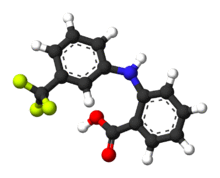 | |
 | |
| Clinical data | |
|---|---|
| AHFS/Drugs.com | International Drug Names |
| Routes of administration | oral, topical |
| ATC code | |
| Legal status | |
| Legal status |
|
| Pharmacokinetic data | |
| Protein binding | extensively |
| Metabolism | Hydroxylation, glucuronidation |
| Elimination half-life | ~3 h |
| Excretion | 50% urine, 36% feces |
| Identifiers | |
IUPAC name
| |
| CAS Number | |
| PubChem CID | |
| IUPHAR/BPS | |
| DrugBank | |
| ChemSpider | |
| UNII | |
| KEGG | |
| ChEBI | |
| ChEMBL | |
| CompTox Dashboard (EPA) | |
| ECHA InfoCard | 100.007.723 |
| Chemical and physical data | |
| Formula | C14H10F3NO2 |
| Molar mass | 281.234 g·mol−1 |
| 3D model (JSmol) | |
| Melting point | 124 to 125 °C (255 to 257 °F) resolidification and remelting at 134°C to 136°C |
| Solubility in water | Practically insoluble in water; soluble in ethanol, chloroform and diethyl ether mg/mL (20 °C) |
SMILES
| |
| |
| (verify) | |
Flufenamic acid (FFA) is a member of the anthranilic acid derivatives (or fenamate) class of NSAID drugs[1]:718 Like other members of the class, it is a COX inhibitor and prevents formation of prostaglandins.[2] FFA is known to bind to and reduce the activity of prostaglandin F synthase and activate TRPC6.[3]
It is not widely used in humans as it has a high rate (30-60%) of gastrointestinal side effects.[4]:310 It is generally not available in the US.[2] It is available in some Asian and European countries as a generic.[5]
Scientists led by Claude Winder from Parke-Davis invented FFA in 1963, along with fellow members of the class, mefenamic acid in 1961 and meclofenamate sodium in 1964.[1]:718
References
- ^ a b Whitehouse MW (2005). "Drugs to treat inflammation: a historical introduction". Current Medicinal Chemistry. 12 (25): 2931–42. doi:10.2174/092986705774462879. ISBN 9781608052073. PMID 16378496.
- ^ a b NIH LiverTox Database Mefenamic Acid Last updated June 23, 2015. Page accessed July 3, 2015. Quote: "(fenamates generally not available in the United States, such as tolfenamic acid and flufenamic acid)"
- ^ "Chemical–Gene Interaction Query: Flufenamic Acid (Homo sapiens)". Comparative Toxicogenomics Database. North Carolina State University. Retrieved 4 July 2015.
- ^ Aronson JK (2009). Meyler's Side Effects of Analgesics and Anti-inflammatory Drugs. Elsevier. ISBN 978-0-08-093294-1.
- ^ "International listings for flufenamic acid". Drugs.com. Retrieved 3 July 2015.